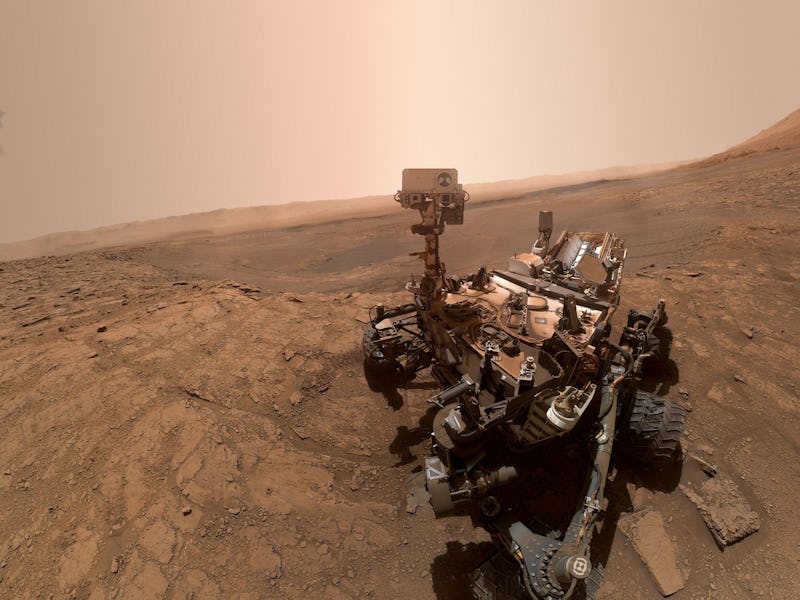NASA just found these organic molecules on Mars for the first time
The Curiosity rover demonstrated a useful technique to search for Martian biosignatures.

After spending 1,909 Martian sols on the Red Planet, NASA’s Curiosity rover was suffering from a slight malfunction.
The robot’s drill stopped working while Curiosity was on Mars’ Vera Rubin ridge at the base of Mount Sharp. The rover had collected a sample of Martian dirt, and the team behind the mission decided to go a different route.
Instead of dropping the sample into one of the cups in the sample carousel, they dropped it into a cup pre-filled with a chemical mixture. The molecules released from the cup were then trapped and analyzed, revealing organic molecules on Mars that no space agency had previously detected.
The scientists detailed their discovery in a study published Monday in the journal Nature Astronomy.
Maëva Millan, a postdoctoral fellow at NASA’s Goddard Spaceflight Center and lead author of the new study, explains that the initial motivation behind the experiment was to have a reference for future chemistry experiments conducted on Mars samples.
“This experiment was definitely successful,” Millan tells Inverse. “While we haven’t found what we were looking for, biosignatures, we showed that this technique is really promising.”
HERE’S THE BACKGROUND — NASA’s Curiosity rover landed on Gale Crater on August 6, 2012, and has been roaming the Martian terrain ever since.
The Curiosity rover was recently joined by NASA’s Perseverance rover which landed on Mars on February 18.
The mission aims to search for signs of ancient life on Mars.
Although Mars is cold and barren today, it may have once had flowing rivers and pooling lakes. Scientists believe that the planet may have once been habitable and possibly hosted ancient microbial life during its early history.
To search for that life, scientists look for biosignatures on Mars — certain chemicals that may have been produced by some form of past or present life, be it microbes or something more complex.
Scientists also search for organic molecules. Organic molecules are considered the building blocks of life on Earth — which could carry over to elsewhere in the universe.
The Curiosity rover has previously detected organic molecules buried in Martian sediments, but the new findings add to the list of organic molecules on Mars, further bolstering the case for past habitability.
WHAT’S NEW — In March 2017, Curiosity collected dirt samples from the Bagnold Dune on Mars. Because Curiosity’s drill was out of service at the time, the team decided to conduct a first-of-its-kind experiment. The rover has 74 cups inside its belly, and nine of those cups are pre-filled with a chemical mixture.
“In the regular process, when we collect the sample with the robot arm of Curiosity, we would drop it into one of those cups,” Millan says. “But in this case, we dropped the sample into one of the fields filled with chemical reagents.”
The team did not expect the sample to be rich in well-preserved organic molecules since ionizing radiation had long battered the ancient soil.
But after testing the sample with the chemical mixture, the team behind the mission identified organic molecules never before seen on Mars. The two most significant molecules were benzoic acid and ammonia.
Although these molecules are not biosignatures, they are good indicators of the presence of biosignatures.
“One of the things that we were trying to look for [when searching for] organic molecule on Mars is to understand the past habitability of Mars and to look for bioindicators,” Millan says.
Bagnold Dunes, where the organics were found.
WHAT’S NEXT — After identifying the organic molecules, the team aims to find their origins or “parent molecules.”
“Once we have found that, we can say where they originated from,” Millan says. “As of now, with all the molecules that we have found on Mars, we have made the hypothesis that they could come from geological processes.”
But since Curiosity took the sample from Gale Crater, which is hypothesized to have had water in the past, then the molecules could be possible indicators of past habitability.
The team of scientists behind the study are awaiting the launch of the European Space Agency’s ExoMars mission in 2022 to collect more samples from Mars.
The Perseverance rover is also collecting samples from the Martian surface, which will later be brought to Earth to be analyzed inside a lab.
All the different Martian missions put together different pieces of the puzzle of Mars’ history, and whether or not the Red Planet ever hosted life and whether that life sprouted life on Earth.
Abstract: The wet chemistry experiments on the Sample Analysis at Mars instrument on NASA’s Curiosity rover were designed to facilitate gas chromatography mass spectrometry analyses of polar molecules such as amino acids and carboxylic acids. Here we present the results of such a successful wet chemistry experiment on Mars on sand scooped from the Bagnold Dunes with the N-methyl-N-(tert-butyldimethylsilyl) trifluoroacetamide derivatization agent. No amino-acid derivatives were detected. However, chemically derivatized benzoic acid and ammonia were detected. Mass spectra matching derivatized phosphoric acid and phenol were present, as were several nitrogen-bearing molecules and as yet unidentified high-molecular-weight compounds. The origin of these compounds, including those that may be internal to the Sample Analysis at Mars background, is examined. This derivatization experiment on Mars has expanded the inventory of molecules present in Martian samples and demonstrated a powerful tool to further enable the search for polar organic molecules of biotic or prebiotic relevance.
This article was originally published on